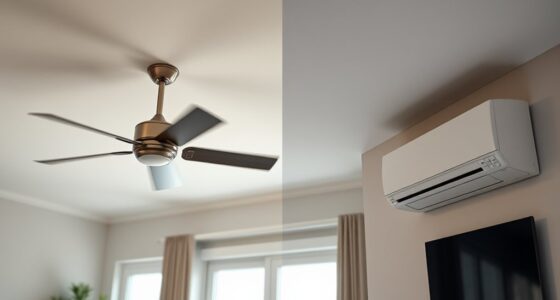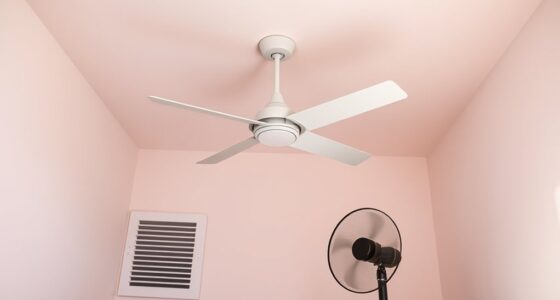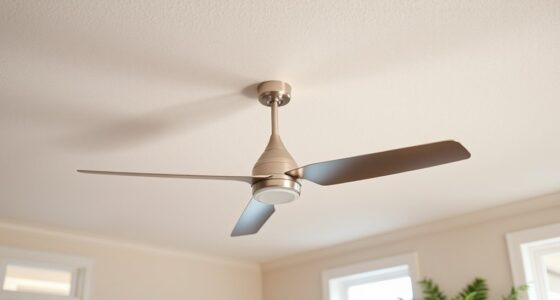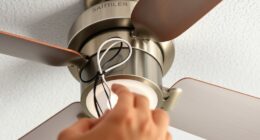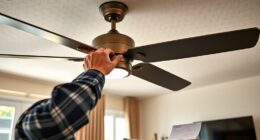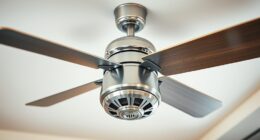Many believe ceiling fans cool rooms directly, but actually, they just create a breeze that makes you feel cooler by increasing evaporation on your skin. Fans won’t lower the room’s temperature or replace ventilation systems, like exhaust fans. Proper fan direction, size, and placement are essential for effectiveness, especially across seasons. If you want to learn how to optimize airflow, ventilation, and energy savings, keep exploring this guide for real insights.
Key Takeaways
- Fans do not lower actual room temperature; they only create a breeze that enhances perceived cooling through evaporation.
- Oversized fans in small rooms can cause turbulence and discomfort, regardless of fan size.
- Ceiling fans should spin counterclockwise in summer for cooling and clockwise in winter to circulate warm air.
- Fans improve airflow but do not remove odors, moisture, or pollutants; proper ventilation is still necessary.
- Proper placement, size, and blade design are essential for maximizing airflow and energy efficiency, dispelling common myths.
Debunking the Myth: Ceiling Fans Don’t Cool the Room Alone
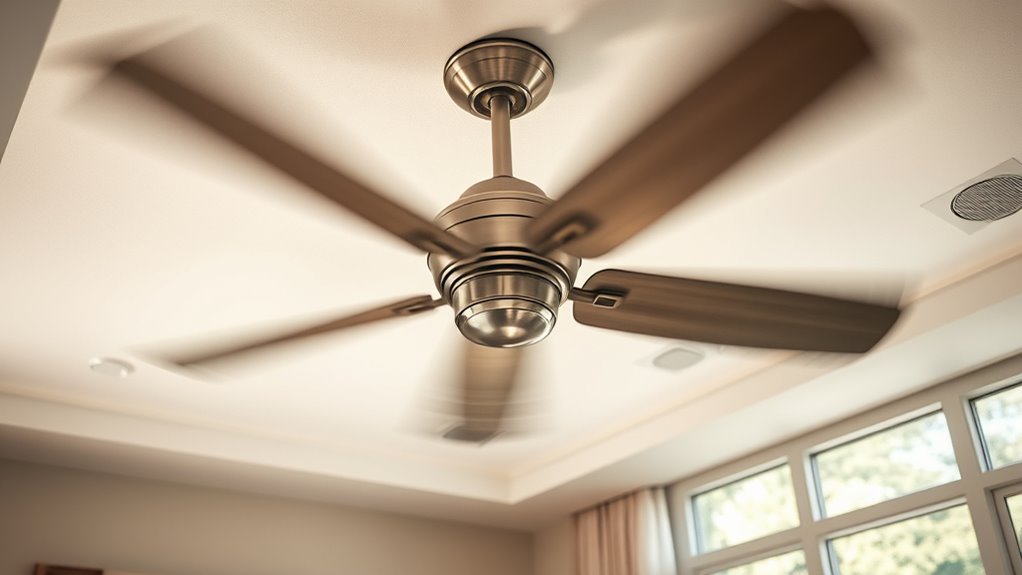
Many people believe that ceiling fans can directly lower the temperature of a room, but that’s a myth. This is a common airflow misconception—fans don’t actually cool the air itself. Instead, they create a breeze that increases evaporation on your skin, making you feel cooler. This is a key reason why ceiling fans are often misunderstood as cooling devices when they’re really just improving perceived comfort. Relying on fans alone to lower your room’s temperature is a cooling myth; they don’t change the air’s thermal energy. Instead, they help circulate air, which can improve ventilation and comfort. Understanding this distinction helps you use ceiling fans more effectively, knowing they’re tools for airflow and comfort, not actual temperature reduction. Additionally, sound vibrations from certain technologies are being explored for their potential to enhance health and relaxation, highlighting the importance of proper airflow and environment in overall well-being.
Which Direction Should Your Fan Spin for Optimal Airflow?
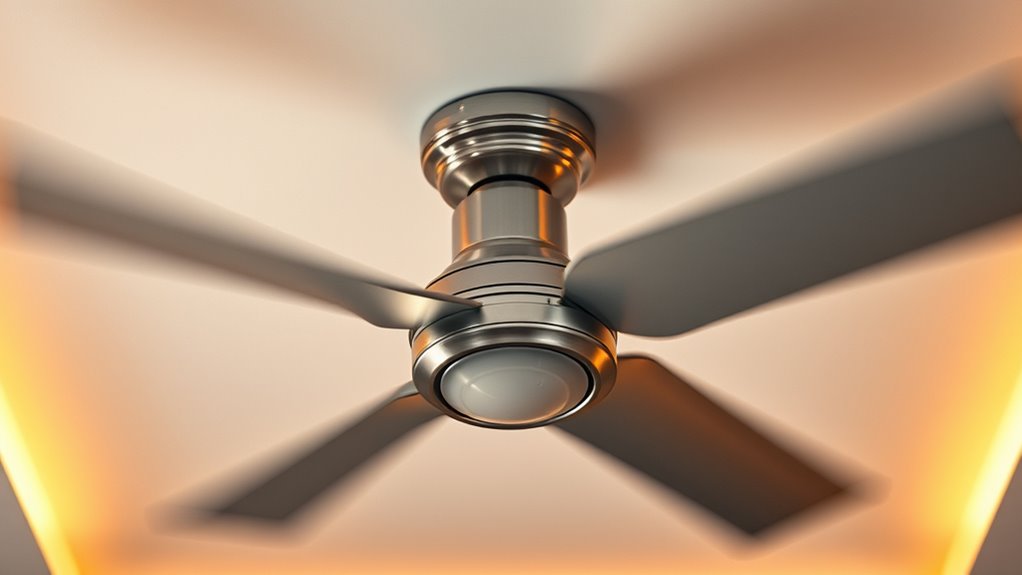
To get the most out of your ceiling fan, you need to set the direction correctly. In summer, your fan should spin counterclockwise to create a cooling breeze, while in winter, it should spin clockwise to circulate warm air. Adjusting the direction based on the season helps maximize comfort and energy efficiency. Proper air circulation can also improve overall ventilation in your space.
Summer: Fan Spins Counterclockwise
During the summer months, setting your ceiling fan to spin counterclockwise creates a cooling breeze that helps you feel more comfortable. This direction maximizes air circulation, making the room feel cooler without lowering the thermostat. Additionally, it can lead to energy savings by reducing the need for air conditioning. To optimize airflow, consider these tips:
- Ensure the fan blades tilt slightly downward for better air movement.
- Use the fan in conjunction with open windows to promote cross-ventilation.
- Adjust the fan speed to achieve a gentle, consistent breeze.
- Confirm the fan’s rotation direction periodically, especially after maintenance or power outages.
- Remember that proper airflow is key to creating a comfortable and energy-efficient environment during hot weather.
Following these steps enhances airflow efficiency and reduces energy costs, ensuring a more comfortable summer experience.
Winter: Fan Spins Clockwise
In winter, setting your ceiling fan to spin clockwise helps circulate warm air trapped near the ceiling, keeping the room warmer without increasing the heater’s workload. This gentle, downward airflow pushes the warm air near the ceiling down into the living space, reducing the need to turn up the thermostat adjustment. Make sure to run the fan at a low speed to minimize fan noise and avoid disturbing the room’s quiet. If your fan has a reverse switch, switch it to clockwise, which creates a subtle breeze that promotes even heat distribution. This setup ensures comfort without creating a draft or excessive noise. Using your fan correctly in winter can improve energy efficiency and maintain a cozy environment. Additionally, proper automation of fan settings can optimize airflow and energy savings throughout the season.
Ceiling Fans and Ventilation: Do They Replace Exhaust Fans?
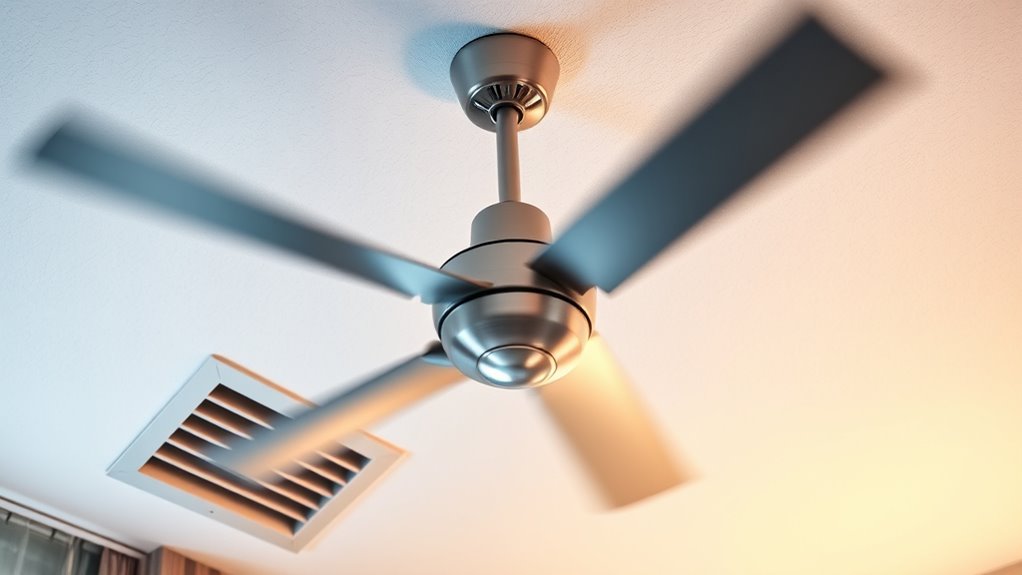
Have you ever wondered if ceiling fans can truly replace exhaust fans when it comes to ventilation? While ceiling fans circulate air, they don’t remove odors, moisture, or pollutants. They’re not a substitute for exhaust fans, especially when it comes to proper ventilation. To optimize airflow, consider these points:
- Exhaust fans actively extract stale air, moisture, and odors.
- Ceiling fans improve air circulation but don’t reduce humidity levels.
- Integrating air purifiers with ceiling fans enhances indoor air quality.
- Proper ventilation requires a combination of exhaust fans and ceiling fans for humidity control.
- A high contrast ratio in projectors ensures better image quality in varying lighting conditions, which is essential for creating an optimal viewing environment.
Ceiling fans can complement ventilation, but they shouldn’t replace exhaust systems, particularly in spaces needing air purifier integration or humidity regulation.
The Truth About Ceiling Fans and Air Circulation in Different Seasons

Ceiling fans can be effective tools for air circulation throughout the year, but their impact varies with the seasons. In summer, they create a cooling breeze that helps you feel more comfortable, while in winter, reversing the fan’s direction can promote better airflow by pushing warm air down. They also assist with humidity control, making high humidity days more bearable by increasing air movement. However, noise levels can sometimes be a concern, especially with older or cheaper models, so choose fans with quiet operation if you’re sensitive to sound. Remember, fans don’t actually lower temperature or humidity but improve comfort by enhancing air circulation. Adjusting your ceiling fan appropriately for each season ensures you maximize its benefits without unnecessary noise or discomfort. Proper airflow management can significantly enhance your overall comfort and energy efficiency.
Myths About Ceiling Fan Placement and Room Size
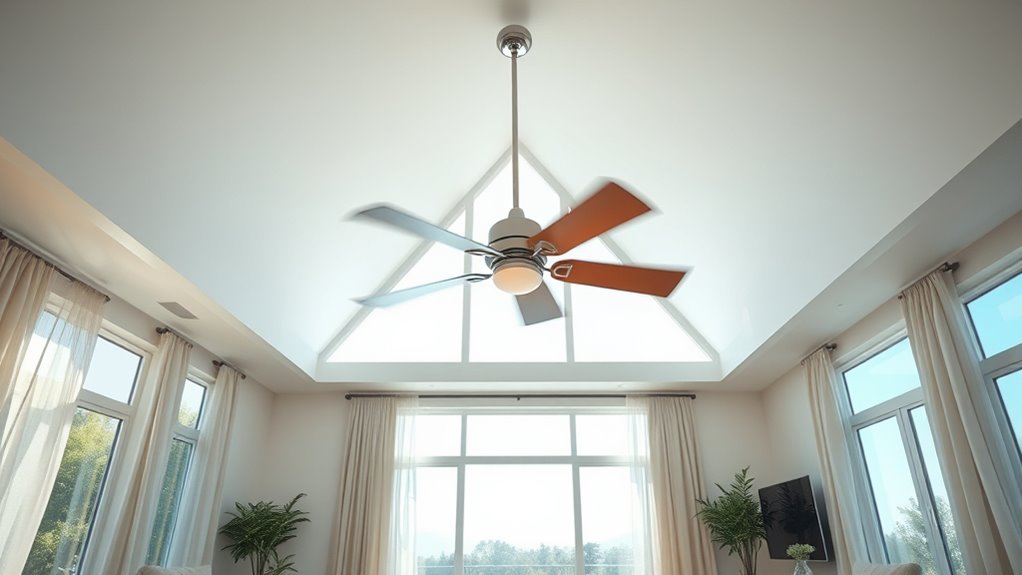
Many believe that small rooms need tiny fans, or that big fans are only for large spaces. In reality, the size and shape of your room, along with ceiling height, influence the best fan placement. Understanding these factors helps you choose the right fan for any room size or layout. Additionally, considering airflow efficiency can ensure optimal ventilation performance regardless of room dimensions.
Small Rooms, Big Fans
Despite common beliefs, using a large ceiling fan in a small room doesn’t necessarily improve comfort or efficiency. The key is matching fan size to room dimensions. An oversized fan might create excessive airflow, leading to discomfort rather than relief. Consider these points:
- Larger fans aren’t always better for small spaces.
- Ideal fan size depends on room dimensions, typically a diameter of 36-52 inches for small rooms.
- Proper placement is essential; a fan should be centered for even airflow.
- Oversized fans can cause turbulence, reducing comfort and increasing energy use.
Focusing on the right fan size ensures you get effective airflow without wasting energy or causing discomfort. Remember, bigger isn’t always better—suit your fan size to your room’s specific dimensions.
Large Spaces, High Fans
While it’s common to think that installing high-mounted fans is essential for large rooms, this isn’t always the case. Your ceiling height and room size determine the best fan placement and size. A very tall ceiling doesn’t mean you need a larger fan or one mounted high up. Instead, focus on choosing a fan size proportional to the room’s dimensions for ideal airflow. Larger rooms benefit from bigger fans, but mounting height should be comfortable—typically around 8 to 9 feet above the floor. Installing a fan too high can reduce its effectiveness, as airflow struggles to reach the occupied space. Proper placement and fan size are more important than just ceiling height, ensuring efficient cooling without unnecessary installation challenges.
Room Shape Matters
The shape of your room considerably influences the effectiveness of your ceiling fan placement. Different room shapes and ceiling heights require tailored strategies to maximize airflow. For example, a rectangular room benefits from fans placed near the center, while a circular room may need multiple fans for even circulation. High ceilings often demand fans with longer downrods to ensure proper air movement. Consider these factors:
- Rectangular rooms with standard ceiling heights need fans centered on the longer dimension.
- Rooms with vaulted or cathedral ceilings benefit from fans with extended downrods.
- Irregularly shaped rooms may require multiple fans for balanced airflow.
- Low ceilings necessitate compact fans positioned close to the ceiling to avoid obstructions.
- Understanding your room’s shape and ceiling height ensures maximum fan placement and efficient ventilation, especially when selecting appropriate fan types that suit your specific room configuration.
Do Ceiling Fans Really Save Energy and Reduce Cooling Costs?
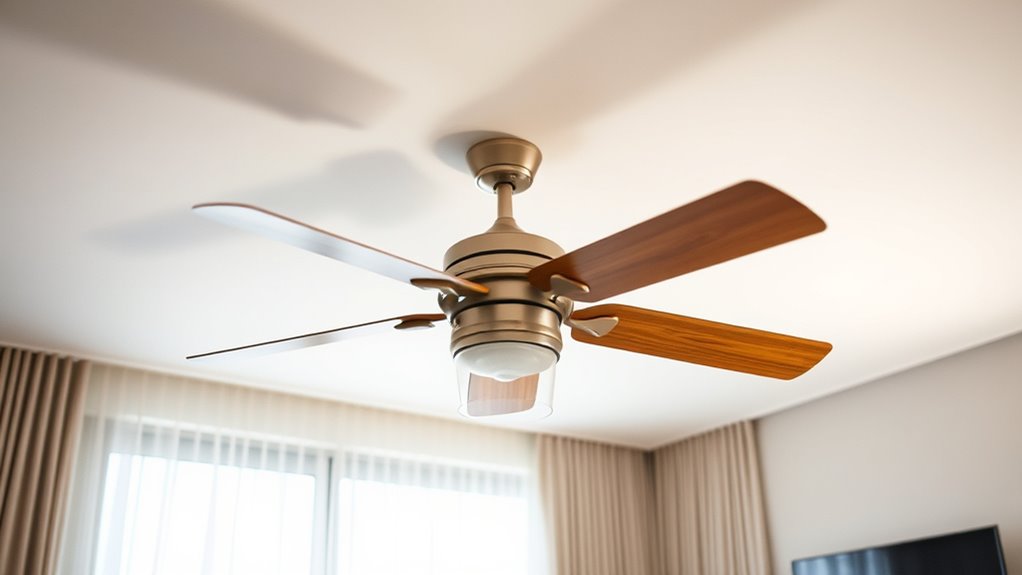
Are ceiling fans a smart way to cut down on energy bills and cooling costs? In many cases, they do promote energy savings and cost reduction. Ceiling fans use remarkably less electricity than air conditioners, helping you lower your overall energy consumption. By circulating air efficiently, fans make rooms feel cooler without actually lowering the temperature, allowing you to set your thermostat higher. This reduces the load on your AC, leading to less energy use and lower bills. Additionally, proper fan placement can maximize airflow effectiveness and further enhance energy efficiency. However, fans alone won’t replace air conditioning during extreme heat, but they complement it well. When used properly, ceiling fans can improve comfort while saving you money on cooling costs, making them a practical addition to your energy-efficient home.
Can Ceiling Fans Help Improve Indoor Air Quality?
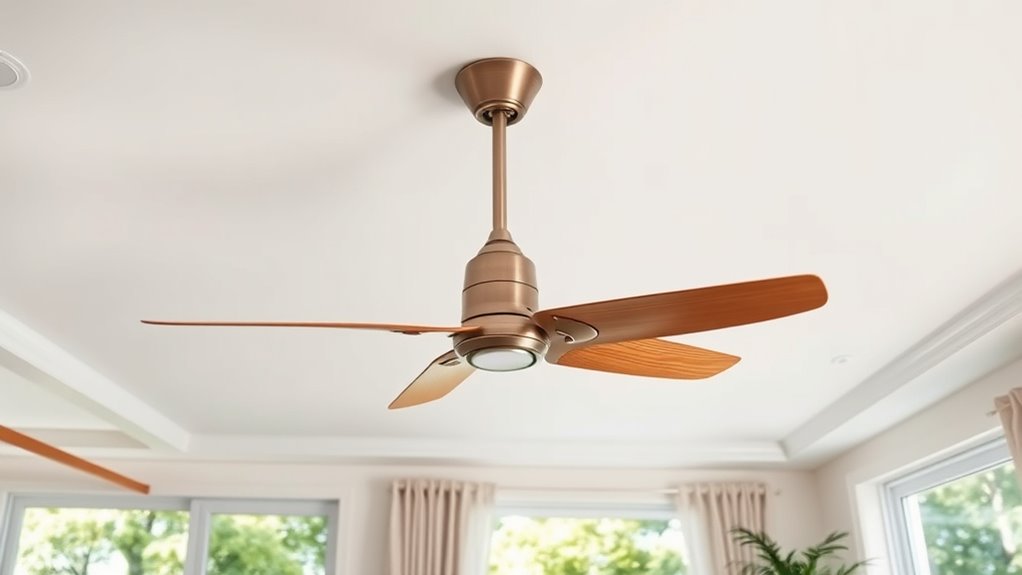
Ceiling fans can play a role in improving indoor air quality by promoting better air circulation throughout your home. This helps prevent the buildup of indoor pollutants and stale air, making your environment healthier. To maximize this benefit, consider these factors:
Ceiling fans enhance air circulation, reducing indoor pollutants and stale air for a healthier home environment.
- Use ceiling fans alongside air quality sensors to detect and address pollutant levels.
- Enhance airflow to reduce indoor pollutants like dust, allergens, and odors.
- Ensure proper ventilation in conjunction with fan operation for continuous air exchange.
- Regularly clean fan blades and vents to prevent circulating dust and allergens.
- Incorporating tuning modifications to your ceiling fan setup can optimize airflow performance and further support indoor air quality.
While ceiling fans don’t filter pollutants directly, their circulation improves the overall air quality by dispersing indoor pollutants more evenly, aiding your home’s ventilation efforts.
The Impact of Fan Blades Shape and Material on Airflow Efficiency

Fan blades’ shape and material substantially influence airflow efficiency, determining how effectively your ceiling fan circulates air. The blade design affects how smoothly air moves, while material influence impacts durability and performance. For example, lightweight materials like plastic enable faster rotation, boosting airflow, whereas heavier metals may generate quieter operation. The shape also matters; curved blades create better air movement than flat ones. Here’s a quick comparison:
| Blade Shape | Material Influence | Effect on Airflow |
|---|---|---|
| Curved | Lightweight plastic | Maximizes circulation |
| Flat | Metal or wood | Less efficient |
| Angled | Composite | Better air movement |
| Wide blades | Reinforced materials | More airflow, quieter |
Additionally, the energy efficiency of the fan is affected by blade design, with optimized shapes reducing energy consumption while maintaining high airflow.
Common Mistakes That Limit Your Ceiling Fan’s Effectiveness

Many common mistakes can substantially reduce your ceiling fan’s airflow and overall efficiency. One mistake is ignoring blade design; poorly designed blades can cause uneven airflow and noise. Second, using fan materials that warp or degrade over time diminishes performance. Third, installing the fan too high or too low affects air circulation—optimal height is key. Fourth, operating the fan at inappropriate speeds or leaving it on when unnecessary wastes energy and reduces effectiveness. Additionally, neglecting to balance the blades can create wobbling, decreasing airflow. Ensuring your fan has a suitable blade design, durable materials, proper height, and balanced blades will maximize airflow and efficiency. Furthermore, understanding remote control capabilities can help optimize fan operation for different needs. Avoid these mistakes, and your ceiling fan will work as intended, providing better ventilation and comfort.
Frequently Asked Questions
Can Ceiling Fans Improve Airflow in Rooms With High Ceilings?
Yes, ceiling fans can improve airflow in rooms with high ceilings. They help create better airflow patterns by circulating air more effectively, which can prevent hot or stagnant spots. When you use a fan with an appropriate ceiling height, especially one with an adjustable downrod, it guarantees ideal air movement. This enhances comfort and ventilation, making high-ceiling rooms feel cooler and more balanced.
How Does Ceiling Fan Speed Affect Air Circulation Efficiency?
You’ll notice that increasing your ceiling fan speed improves air circulation because higher speeds move more air quickly. The fan blade design and motor power play key roles, with well-designed blades pushing air efficiently at different speeds. However, running the fan at maximum speed continuously isn’t always best; find a balance that maintains comfort without wasting energy, ensuring ideal airflow and ventilation in your space.
Are There Specific Ceiling Fan Features That Enhance Ventilation Performance?
You can improve ventilation performance with ceiling fans featuring advanced blade design and high motor efficiency. Look for fans with aerodynamically shaped blades, which move air more effectively, and motors that use less energy while providing strong airflow. These features guarantee better circulation, helping you stay cool and maintain good air quality. Investing in a fan with these enhancements makes a noticeable difference in your room’s ventilation performance.
Do Ceiling Fans Help Reduce Indoor Humidity Levels?
Ceiling fans don’t directly lower indoor humidity levels, but they help with humidity control by creating a breeze that promotes evaporation and makes rooms feel cooler. This airflow improves air quality by reducing stuffiness and dampness, making the space more comfortable. Keep in mind, for actual humidity reduction, you’ll need a dehumidifier, but ceiling fans are great for enhancing ventilation and maintaining a balanced, comfortable environment.
Can Ceiling Fans Be Effective in Outdoor or Covered Patio Spaces?
Think of your outdoor space as a sanctuary needing gentle guardians. Ceiling fans can be effective in outdoor or covered patio spaces, providing outdoor cooling and enhancing patio comfort. They create a breeze that feels like a whisper of relief, making your outdoor retreat more enjoyable. So yes, installing a ceiling fan outside helps circulate air, making your patio more inviting and comfortable, even when the sun’s blazing.
Conclusion
Remember, ceiling fans are your silent partners in comfort, not magic wands. Like a gentle breeze guiding a ship through calm waters, their true power lies in proper placement, direction, and understanding their limits. By dispelling myths and embracing the truth, you harness their full potential—transforming your space into a sanctuary where air flows freely, and comfort reigns. Embrace the wind’s whisper, and let your ceiling fan be your guiding star.



